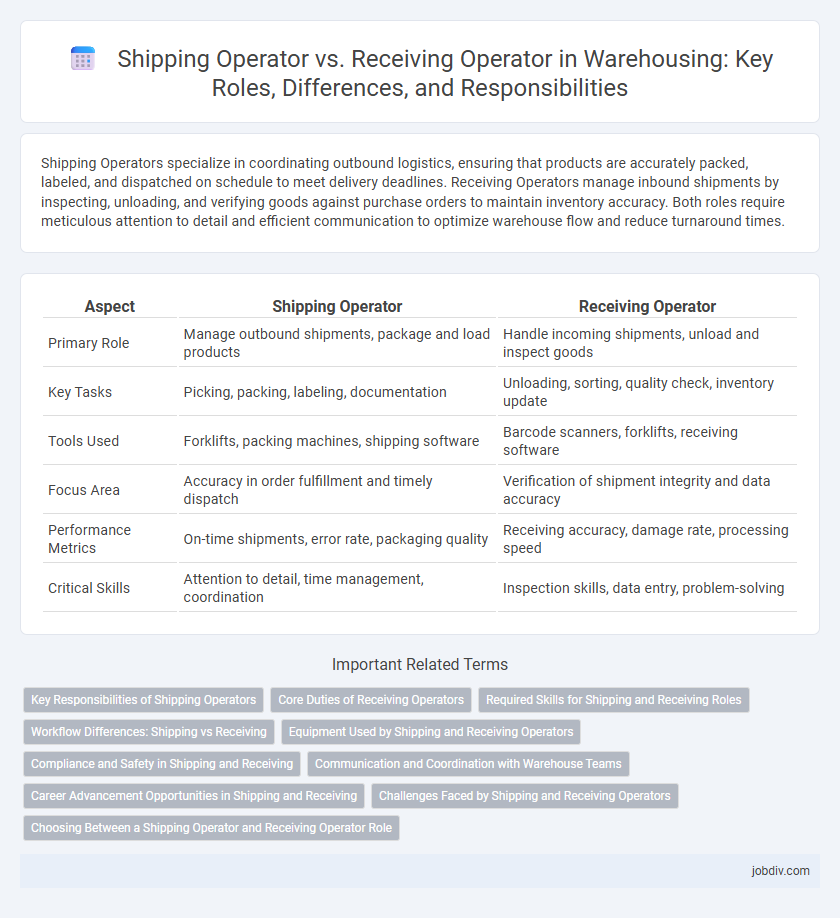Shipping Operators specialize in coordinating outbound logistics, ensuring that products are accurately packed, labeled, and dispatched on schedule to meet delivery deadlines. Receiving Operators manage inbound shipments by inspecting, unloading, and verifying goods against purchase orders to maintain inventory accuracy. Both roles require meticulous attention to detail and efficient communication to optimize warehouse flow and reduce turnaround times.
Table of Comparison
| Aspect | Shipping Operator | Receiving Operator |
|---|---|---|
| Primary Role | Manage outbound shipments, package and load products | Handle incoming shipments, unload and inspect goods |
| Key Tasks | Picking, packing, labeling, documentation | Unloading, sorting, quality check, inventory update |
| Tools Used | Forklifts, packing machines, shipping software | Barcode scanners, forklifts, receiving software |
| Focus Area | Accuracy in order fulfillment and timely dispatch | Verification of shipment integrity and data accuracy |
| Performance Metrics | On-time shipments, error rate, packaging quality | Receiving accuracy, damage rate, processing speed |
| Critical Skills | Attention to detail, time management, coordination | Inspection skills, data entry, problem-solving |
Key Responsibilities of Shipping Operators
Shipping Operators manage the accurate preparation and dispatch of outgoing shipments, ensuring all items are picked, packed, and labeled according to order specifications. They coordinate with carriers to schedule pickups, verify shipping documents, and maintain records for tracking and compliance. Maintaining inventory accuracy through timely updates in warehouse management systems is a critical responsibility of Shipping Operators.
Core Duties of Receiving Operators
Receiving operators specialize in inspecting and verifying incoming shipments to ensure accuracy against purchase orders and delivery documents. They are responsible for unloading goods, checking for damages, and properly documenting received inventory in the warehouse management system. Their core duties also include labeling, sorting, and organizing products for efficient storage and quick retrieval.
Required Skills for Shipping and Receiving Roles
Shipping operators require strong organizational skills, attention to detail, and proficiency in logistics software to efficiently manage outbound shipments and ensure accurate order fulfillment. Receiving operators must possess excellent inventory control abilities, keen inspection skills, and familiarity with warehouse management systems to accurately process incoming goods and maintain stock accuracy. Both roles demand effective communication, teamwork, and knowledge of safety protocols to optimize warehouse operations and prevent errors.
Workflow Differences: Shipping vs Receiving
Shipping operators concentrate on order picking, packing, and labeling to prepare items for outbound delivery, ensuring accuracy and adherence to shipping schedules. Receiving operators focus on inspecting incoming shipments, verifying quantities against purchase orders, and organizing goods for storage or cross-docking. Workflow differences are marked by shipping emphasizing outbound logistics and customer dispatch, while receiving prioritizes inbound inspection and inventory intake.
Equipment Used by Shipping and Receiving Operators
Shipping operators primarily use equipment such as conveyor belts, pallet jacks, and stretch wrap machines to prepare and dispatch outgoing shipments efficiently. Receiving operators commonly utilize forklifts, barcode scanners, and weighing scales to unload, inspect, and document incoming goods accurately. Both roles rely on warehouse management systems (WMS) integrated with handheld devices to streamline operations and maintain inventory accuracy.
Compliance and Safety in Shipping and Receiving
Shipping Operators and Receiving Operators play crucial roles in warehouse compliance and safety by adhering to strict protocols that minimize errors and hazards. Shipping Operators focus on accurate order fulfillment, proper packaging, and verifying shipment documentation to ensure regulatory compliance and prevent damage during transit. Receiving Operators are responsible for inspecting incoming goods, documenting discrepancies, and maintaining safety standards to avoid contamination, injury, or inventory inaccuracies.
Communication and Coordination with Warehouse Teams
Shipping operators streamline outbound logistics by maintaining real-time communication with inventory control and packaging teams, ensuring timely dispatch and accurate order fulfillment. Receiving operators coordinate closely with quality control and storage teams to verify incoming shipments, update inventory systems promptly, and resolve discrepancies efficiently. Both roles rely heavily on seamless coordination to optimize warehouse throughput and minimize operational delays.
Career Advancement Opportunities in Shipping and Receiving
Shipping operators often have opportunities to advance into logistics coordination or supply chain management due to their expertise in dispatch, inventory tracking, and transportation scheduling. Receiving operators can progress toward inventory control or warehouse management roles by leveraging skills in quality inspection, stock reconciliation, and inbound logistics. Both paths offer career growth through specialization in warehouse systems, leadership development, and cross-functional experience in operations.
Challenges Faced by Shipping and Receiving Operators
Shipping operators frequently face challenges such as coordinating timely dispatches to meet tight delivery schedules, managing accurate inventory counts to prevent stock discrepancies, and handling packaging requirements to avoid transit damage. Receiving operators encounter difficulties including verifying shipment accuracy against purchase orders, efficiently processing high volumes of incoming goods during peak periods, and identifying and managing damaged or incorrect shipments to maintain inventory integrity. Both roles require effective communication, meticulous record-keeping, and adaptability to fluctuating workloads to minimize operational disruptions in warehousing environments.
Choosing Between a Shipping Operator and Receiving Operator Role
Choosing between a shipping operator and a receiving operator role depends on key warehouse functions and workflow efficiency. Shipping operators specialize in order fulfillment, package handling, and dispatch logistics, optimizing outbound shipment accuracy and timely delivery. Receiving operators focus on inventory intake, quality control, and proper storage, ensuring accurate stock management and minimizing discrepancies during inbound processes.
Shipping Operator vs Receiving Operator Infographic

 jobdiv.com
jobdiv.com